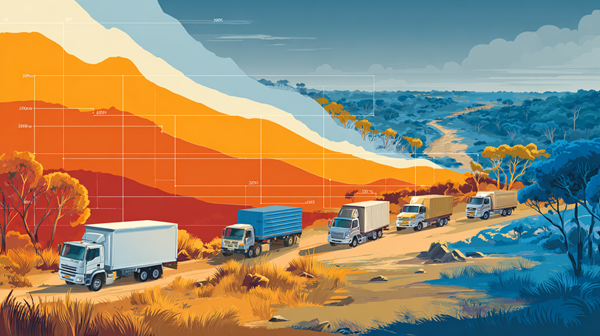Fleet finance made smarter—Discover how residual value forecasting affects monthly costs, end-of-term exposure, and tax strategy for Australian businesses financing utes, trucks, and vans.
Key takeaways
- Residual value matters more than you think — For Australian commercial vehicles, residual values typically range between 35% and 55% of the original purchase price. This figure directly shapes your monthly finance repayments.
- Lower repayments, better cash flow — Accurately forecasting residual values can reduce your monthly repayments by up to 20%, giving your business more breathing room without sacrificing vehicle quality.
- Getting it wrong can cost you — Overestimating residuals lowers repayments but risks a shortfall at the end of term if resale values drop. Underestimating increases monthly costs but gives you more certainty later.
- Vehicle type and market trends count — Residual values are affected by make, model, usage, fuel type, condition, and economic factors like inflation, fuel prices, and resale market trends.
- Finance type makes a difference — Chattel mortgages, hire purchase, and finance leases treat residuals differently. Choosing the right finance structure helps you align repayment profiles with business cash flow.
- Plan with strategy, not guesswork — Align your residual assumptions with business goals. For example, fleet managers aiming to rotate vehicles every 3–4 years should take a conservative residual value approach to avoid balloon risks.
- Tax and write-offs still apply — Your residual value can influence depreciation schedules and GST claims. Always match your finance terms and asset treatment with the latest ATO guidance.
Introduction
When it comes to financing your commercial vehicle fleet, one factor that can significantly influence your costs and risks is the residual value — the projected value of your vehicle at the end of the finance contract. For many Australian businesses, grasping how residual values work and their impact on finance decisions is crucial to managing cash flow, minimising repayments, and planning for vehicle upgrades or replacements.
In this guide, we’ll unpack residual values, how they affect your finance agreements, and practical tips to optimise your fleet financing strategy in today’s Australian market.
What is residual value?
Residual value is the forecasted resale or trade-in value of your vehicle once your finance term finishes. It reflects what the lender expects the vehicle to be worth at that future date. This figure is critical in calculating your repayment schedule and overall finance cost.
- Expressed as a percentage of the vehicle’s purchase price (often called the “capital cost”).
- For Australian commercial vehicles, residual values typically range between 35% and 55% over 3-5 years, depending on vehicle type and market trends.
- A higher residual value means lower monthly repayments but higher risk if the vehicle’s market value falls below this estimate.
Why residual values matter in fleet finance
Understanding residual values impacts your finance decisions in several key ways:
- Monthly repayments: Your repayments are calculated based on the difference between the vehicle price and residual value, plus interest and fees. Higher residuals reduce repayments.
- End-of-term options: For leases and hire purchases, you may have the option to buy the vehicle for the residual value. If the vehicle’s actual market value is lower, you could face a loss.
- Risk management: Overestimating residual values can leave you exposed to depreciation losses, especially in volatile markets. Underestimating can increase repayments but reduce end-of-term risk.
- Cash flow optimisation: Businesses can manage working capital better by selecting finance options aligned with realistic residual value expectations.
Factors influencing residual values in the Australian market
Several elements shape the residual value your lender will assign:
- Vehicle make and model: Brands known for reliability and strong resale value (e.g., Toyota Hilux, Ford Ranger) tend to have higher residuals.
- Vehicle type and usage: Utes and light commercial vehicles often hold value better than heavy trucks or specialised vehicles. Usage patterns and kilometres driven affect depreciation.
- Market demand: Supply chain disruptions or shifts towards electric vehicles (EVs) can change residual values quickly. For example, growing demand for EV utes may impact residual values for petrol models.
- Economic conditions: Inflation, fuel prices, and changes in interest rates influence vehicle values and finance costs.
- Condition and maintenance: Well-maintained vehicles with full service history retain value better.
Residual value across common fleet finance options
Your choice of finance product influences how residual value impacts your payments and risks:
- Finance Lease: The residual value is set upfront, and your repayments cover the depreciation plus interest. You don’t own the vehicle unless you pay the residual at term end. If the vehicle is worth less than the residual, the lessor bears the risk.
- Chattel Mortgage: You own the vehicle immediately, so residual value impacts your asset’s book value and depreciation claims. Repayments are structured to pay off the full purchase price including interest, so residual value does not affect repayments directly.
- Hire Purchase: You pay down the vehicle cost plus interest over time. Residual values don’t affect your repayments, but you gain ownership at the end.
How to use residual value insights to optimise your fleet finance
- Assess your business’s risk tolerance
- Decide whether you prefer lower repayments with some residual risk (finance lease) or higher repayments with full ownership and no residual risk (chattel mortgage or hire purchase).
- Choose vehicles with strong resale value
- Selecting popular, reliable models can help maximise residual value estimates and reduce your overall costs.
- Plan your finance term strategically
- Typical terms range from 3 to 5 years — shorter terms often have higher repayments but reduce residual risk; longer terms lower repayments but increase exposure to depreciation.
- Negotiate residual values carefully
- Work with your financier to understand how residuals are set and negotiate terms that align with your business needs.
- Maintain your vehicles diligently
- Keeping vehicles in excellent condition preserves value, which can lower risks if you decide to sell or trade-in at term end.
- Monitor market trends
- Stay informed on vehicle market shifts — especially the EV transition and supply chain factors — to anticipate changes in residual values.
Tax and accounting implications of residual values
- Depreciation claims: For tax purposes, depreciation deductions are generally based on the vehicle’s effective life and cost minus residual value. A higher residual value reduces your depreciation claim.
- GST considerations: For vehicles financed under a chattel mortgage, you may claim the full GST upfront, but GST on lease payments is spread out if using finance leases. Residual values impact the GST treatment on residual buyouts.
- BAS reporting: Your business activity statement (BAS) must reflect GST claims correctly based on your finance arrangement and residual value implications.
Frequently asked questions
Q: Can residual values change during my finance term?
Residual values are usually fixed at contract start for finance leases and hire purchases. For chattel mortgages, residual values don’t typically apply. However, market conditions affect the actual resale price at term end.
Q: How can I protect my business from residual value risk?
Consider finance options where the lessor assumes residual risk (e.g., finance lease), or opt for shorter terms and buy-back guarantees. Maintaining vehicles well also helps.
Q: Does a higher residual value always mean a better deal?
Not necessarily. While higher residual values lower repayments, they increase your exposure to depreciation losses if the vehicle is worth less than expected at term end.
Q: How do residual values affect cash flow?
Higher residuals reduce monthly repayments, improving cash flow. However, you need to be prepared for a possible lump sum payment or vehicle disposal costs at the end of the term.
Conclusion
Understanding residual values and their impact on your fleet finance decisions is essential for optimising cash flow, managing risk, and planning vehicle upgrades. In the dynamic Australian market, where vehicle values are influenced by supply chain shifts, fuel costs, and the rise of electric vehicles, having a clear grasp of residual value fundamentals empowers your business to choose the right finance option and negotiate favourable terms.
By aligning your residual value expectations with your business goals, vehicle choices, and maintenance practices, you can unlock smarter, more cost-effective fleet finance solutions that keep your operations moving efficiently.


